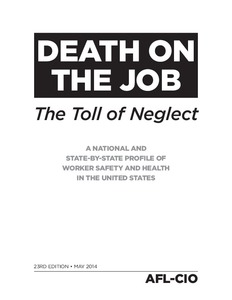Death on the job: the toll of neglect. A national and state-by-state profile of worker safety and health in the United States. 23rd ed.
"Workplaces are much safer today than when the Occupational Safety and Health (OSH) Act was passed in 1970, which promised workers in this country the right to a safe job. The job fatality rate has been cut by 81 percent; more than 492,000 workers lives have been saved. But too many workers rem...
| Institution: | ETUI-European Trade Union Institute |
|---|---|
| Format: | TEXT |
| Language: | English |
| Published: |
Washington, DC
2014
AFL-CIO |
| Subjects: | |
| Online Access: | https://www.labourline.org/KENTIKA-19117640124919358229-Death-on-the-job-the-toll-of-n.htm |
| Summary: | "Workplaces are much safer today than when the Occupational Safety and Health (OSH) Act was passed in 1970, which promised workers in this country the right to a safe job. The job fatality rate has been cut by 81 percent; more than 492,000 workers lives have been saved. But too many workers remain at serious risk of injury, illness or death as workplace tragedies continue to remind us. These tragedies are all preventable. The 2013 explosion at a West, Texas fertilizer plant killed 15 people, most of them volunteer emergency responders, and was caused by an unregulated chemical industry. The 2010 explosion at Massey Energy Upper Big Branch in West Virginia killed 29 miners. The 2010 BP Transocean Gulf coast rig explosion killed 11 workers and caused a major environmental disaster.
In 2012, 4,628 workers were killed on the job in the United States, and an estimated 50,000 died from occupational diseases, resulting in a loss of 150 workers each day from hazardous working conditions. Over the past four years, the job fatality rate has largely been unchanged with a rate of 3.4 deaths per 100,000 workers in 2012." |
|---|---|
| Physical Description: | 202 p. Digital |

